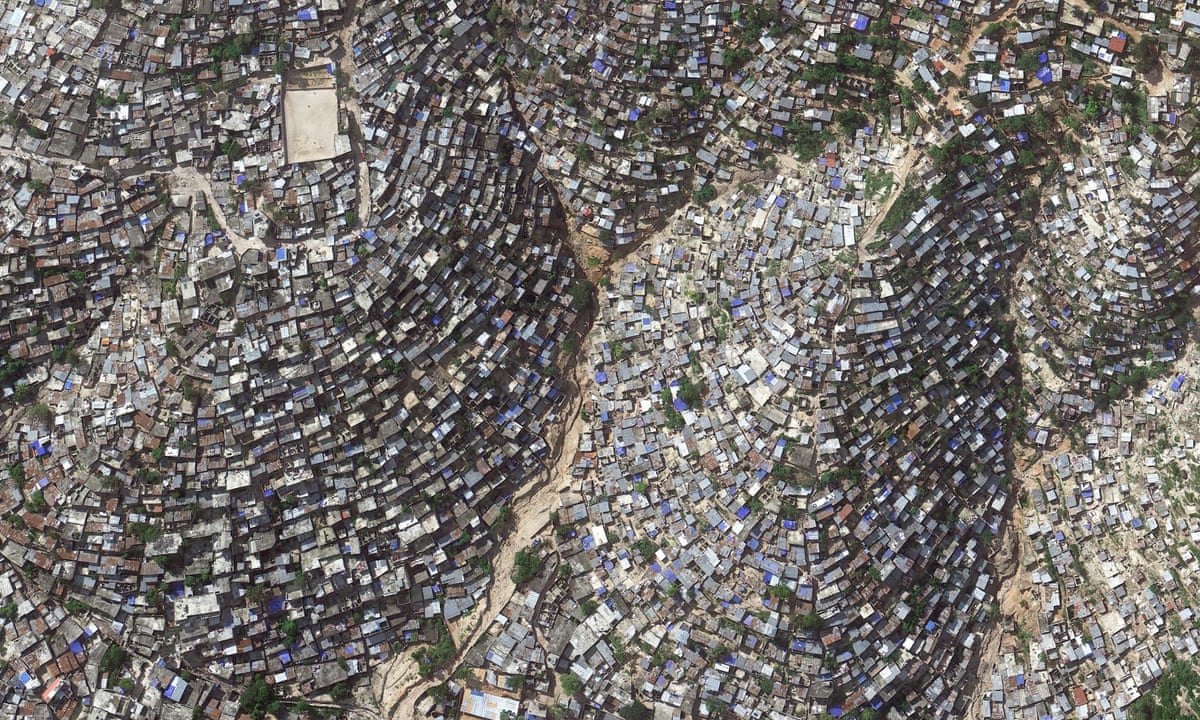Copyright © 2016 - 2025, The Troy Press



Copyright © 2016 - 2025, The Troy Press
Copyright © 2016 - 2025,
The Troy Press 



PHOTO: Majengo district of Nairobi, Kenya, by Steve Bloom
In my last column I showed that human overpopulation is the most basic and fundamental environmental and ecological problem on Earth. Unless we greatly lower our population to, at most, a level that is compatible with the rest of life on our planet, all other attempts at solutions to environmental and ecological problems will be like rearranging the deck chairs on the Titanic. Let's start by looking at how and why we got to where we are, starting when human overpopulation began.
First, I want to be clear about what methods of lowering human population consist of. These methods do NOT consist of killing people to lowerhuman population for two reasons. First, killing people for this or any other reason is totally immoral, and that needs no further discussion. (Killing ANYTHING except to eat is totally immoral, but that's another discussion that I will address in a later column.) Second, killing people does not work to lower human population over time, as is shown by the fact that after major wars that kill millions of people, the decimated populations quickly rebound and in fact increase. So lowering human population is about birth control, not killing.
About 10-12,000 years ago, all humans lived as hunter-gatherers. Since modern humans (aka homo sapiens) began their existence about 200,000 years ago, humans lived as hunter-gatherers for the first 95% of our existence and this is also how all other animals live, with only rare exceptions like ant agriculture. (Whether human agriculture is worse for the natural environment than hunting and gathering is not the subject of this column and will be addressed in detail in another one.) About 10-12,000 years ago, humans began using agriculture, at first in what is now the Middle East, then spreading south into Africa, west into Europe, and east into Asia. People in the Americas and Australia were mostly hunter-gatherers until European colonization.
So, why do I bring up agriculture and hunting & gathering? Because, agriculture was the beginning of human overpopulation. When humans were all hunter-gatherers, there were only ten million people on the entire planet. But like any other animal species, once humans got more available food from agriculture, their population began to explode. This is basic biology: give a group of animals living in nature more food and that group of animals will increase in number, because availability of food is one of the biological limiting factors on population. Human population continued to grow until it reached about one billion at the start of the industrial revolution. This is an increase of two orders of magnitude since people lived as hunter-gatherers.

PHOTO: Human habitation covering all available land on all these hilsides, choking out other life. Credit: The Guardian.
The industrial revolution caused the next major increase in human population growth. The biggest effect of industrial society on overpopulation was artificial fertilizer, part of the so-called Green Revolution that began in the 1930s and that again created more available food for humans. The elimination or virtual elimination of some diseases by modern western medicine also contributed to population growth. Human population now stands at approximately 7.6 billion and growing. There are now approximately 760 TIMES as many people on Earth as there were when humans lived as hunter-gatherers. Between human spaces (living, working, etc.), human infrastructure, and agriculture, humans now take up more than half of the terrestrial (dry) land on Earth. Most of the rest of the terrestrial land is unsuitable for all but the most primordial life, so basically the plants and other animals have nowhere to live because of human overpopulation.
In a nutshell, that's how we got here. It's hard to say whether more than ten million people on Earth is ecologically OK; that is, would having more than ten million people cause harm to plants, other animals, the land, air, or water that would otherwise not be caused if human population were limited to ten million people globally? I don't know if anyone with the expertise and knowledge to do so has ever analyzed this question, and I certainly don't know the answer. But a billion or more people is certainly very ecologically harmful, as that is two orders of magnitude - 100 times - more people than would exist at once if humans were limited to the natural constraints of food availability (human agriculture is not natural, but that's also a subject for another column).
Now, where do we go? Do we just allow human population to continue to increase until overpopulation wipes out a large portion of life on Earth and possibly humans ourselves? If we don't want this result, we must take effective steps to reverse human population growth until the level of our population is low enough to be ecologically compatible with the rest of the species with whom we share our planet. There have been only two methods of reducing human population that have been effective, one voluntary and one at least somewhat coercive. We need both of these methods in order to get an effective result as quickly as possible.
First, let's look at the only way that's been shown to be effective to reduce human birthrates voluntarily: educating and empowering women and girls. The best proof of the effectiveness of this method of lowering birth rates is from Kerala, India. In 1947, Kerala had the highest birthrate in India, which is saying quite a bit. But by the 1970s, Kerala had the lowest birthrate in India. How did Kerala accomplish this complete turnaround from explosive population growth to achieve the lowest birthrates in India, and by he 1990s had achieved replacement rate fertility (that is, no more babies being born than people dying)? By educating women with at least a secondary school education. Kerala also achieved a 100% literacy rate and the highest per capita newspaper readership. Other factors may have been universal health care and a life expectancy equivalent to those in developed countries, but education and empowerment of women were by far the biggest factors, and literacy and reading were the second biggest ones. So getting women college degrees and, even better, PhDs, along with giving them the power to make decisions about birth control is one effective method of at least stopping population growth, if not lowering population.
The effective coercive method was China's one-child-family policy. This policy was implemented in 1979 and lasted until 2013, when some people were allowed to have two children. By 2015, China had allowed everyone to have two children. China had a two-child-family policy in 1970, and it now has one again. China's one-child-family policy has been extensively lied about and otherwise distorted in the U.S., but the facts about this policy are as follows: This was a carrot-and-stick policy that rewarded those who limited their families to one child with things like free health care and education, and withheld those benefits from those who failed to so limit their families. People who illegally had more than one child were also fined. Other sanctions, like forced abortions and infanticides of baby girls, were not part of the policy and were carried out by overzealous local officials and by parents who foolishly valued boy children over girl ones (though Chinese society is also substantially to blame for valuing human males over females). China's one-child-family policy is credited with preventing about 400 million births since its implementation in 1979, and by the year 2060 it is estimated that it will result in one BILLION fewer people in China alone. This is an extreme success in lowering human population. China now has a birthrate of 1.6 -- replacement is 2.1 -- and most young people now don't want to have more than one child, both because they grew up with this policy and it feels normal to them, and because they realize that their lives will be better with fewer children.

PHOTO: Graphic illustrating China's one-child policy overcomes language and illiteracy. Credit: Article, Why China is abandoning its one-child policy. IBTimes.
Because we are in a dire situation of extreme human overpopulation and because we cannot rely on voluntary population reductions by educated and empowered women, we need to both get all women college degrees and empower them to use birth control and abortion without restrictions, and to implement a one-child-family policy in order to lower human population as quickly and humanely as possible. Unfortunately, most people are far too self-centered, and/or don't know and/or care about human overpopulation and its devastating effects on the natural environment to leave the extremely important decision of how many children to have to them, even if the women have PhDs and are empowered to make those decisions. While people in highly individualistic societies like the U.S. will rebel against a one-child-family policy, it must be used in conjunction with educating and empowering women and girls in order to lower human population. We don't just need to reach replacement rates, as they did in Kerala, India, we need to drastically lower our population for the good of the Earth and all that lives here, and we need to do so as quickly as humanely possible.
Discus this article below, or come join us in our Progressive Chat Forum for more general Progressive discussion.